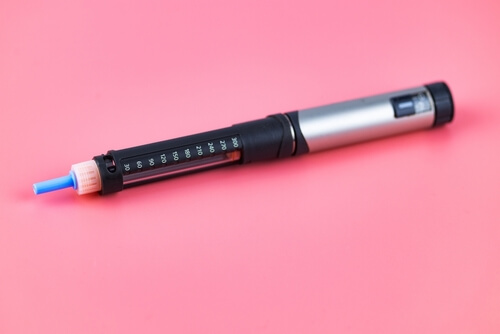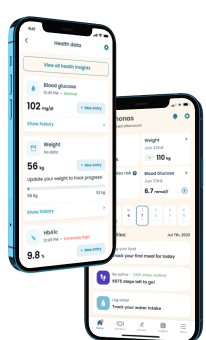Diabetes pens

If you’re a type 2 diabetic patient who requires a daily dose of insulin, you’ve got three choices. You can either use a disposable insulin pen, use a smart pen that comes with reusable insulin cartridges, or use an insulin pump.
In this article, we’ll be focusing mainly on reusable pens and how people with diabetes can use them to manage diabetes.
A while ago, people with diabetes only had two ways to take their multiple daily injections of insulin. They either make use of a disposable pen or get an insulin pump that would be permanently attached to them.
However, a few years ago insulin pens that could deliver multiple daily injections with reusable insulin cartridges entered the market. These pens are called smart insulin pens and are one of the most exciting developments in the treatment of diabetes today. In fact, according to the American Diabetes Association, these pens provide many benefits and improvements for diabetics.
In this article, we’ll be looking at these pens, and how they can make the life of diabetics easier.
Here’s a short rundown of the things we’ll be looking at.
- What Is A Smart Insulin Pen
- How Insulin Pens Got Smart
- How Insulin Pens Work
- How Reusable Pens Are Helping People Living With Diabetes
- Should You Switch From Disposable Insulin Pens To Reusable Insulin Pens
- Commonly Asked Questions
- Bottom Line
What Is A Smart Insulin Pen
An insulin pen is a device that helps diabetes patients inject insulin into their subcutaneous tissue. This tissue is the barrier between your skin and your muscle. The subcutaneous tissue, which is also called the sub Q tissue, can be found all over the body.
These pens usually come with a disposable needle, a cartridge, and a dial that helps the patient’s measure dosage.
There are two types of insulin pens. There are disposable pens that must be thrown away after use, and there are also reusable pens that have cartridges that can be filled.
These reusable pens are usually called smart pens and often come with a software component. This software component means that the pens can help patients with diabetes manage insulin delivery. The software component of these smart pens also helps calculate and track insulin doses. Asides from that, this software component, which is usually just an app, provides reminders, alerts and reports.
Today, the popularity of smart pens has grown rapidly. Nowadays, a lot more people use smart pens because they are easier to use, affordable, and just safer.
Since they help people living with diabetes accurately measure their correct dose of insulin injections, it’s easy to make reach these conclusions. With these pens, people with diabetes will no longer run the risk of rapidly increasing or decreasing their blood sugar because of inaccurate doses.
How Insulin Pens Got Smart
The very first insulin pens were disposable pens that were just good enough for diabetes management. They required an endless supply of diabetes cartridges to work and were a burden on the people who used them.
But at least they worked and were the de facto method of administering daily doses of insulin amongst diabetics. While the very first insulin pens weren’t comfortable to use, at least they ensured that no diabetic ever had to purchase a vial and syringe ever again.
Sure, the insulin cartridges they came with were not reusable, but they also reduced injection site pain, allowed for more accurate dosing, and improved adherence. With the rise of these pens, people with diabetes could now live longer lives and didn’t have to suffer complications as a result of inaccurate doses and non-adherence.
Over time, these devices evolved as most things do, and soon started coming with screens and a microchip that stored data from a previous dose of insulin. Before long, companies started developing data tracking apps that helped these pens keep track of doses and even predict doses.
Once that was incorporated into the original tech, other things like continuous glucose monitoring, dosage timing, reminders and glucose sensing followed. However, despite these innovations, the FDA didn’t approve the use of reusable smart insulin pens until 2017.
That means that the companies who made these innovations had to allow their pens to go under extensive testing to make sure they behaved just as advertised.
These insulin pens on the market now are quite exciting for several reasons. For one, they now can administer half-unit doses. This can be of great help to people who are sensitive to high doses of insulin, such as children and seniors.
Another exciting development with smart pens is the capacity to administer doses in higher concentrations. In the past, it used to be almost impossible to self-administer higher concentrated doses of insulin without endangering oneself. However, these pens make it super easy and comfortable for people to administer these doses.
How Insulin Pens Work
The capacity of an insulin pen varies wildly from one provider to another. Some pens can hold as little as 300 units of insulin, while others may hold as much as 900 units of insulin.
That’s a huge disparity, and if you’re looking to get an insulin pen, that’s something you should consider.
The standard concentration of insulin in an insulin pen is around 100 units per millilitre (mL) of insulin. This is also known as U-100. Now, there are other concentrations like U-200 and U-300, but the standard is U-100.
There are higher doses than this as well, but administering these doses without an insulin pump or a smart pen can be very dangerous. The reason is simple; these doses must be accurate to the last drop, and any variation in any direction could lead to impossible complications for the patient.
Most insulin pens can hold around 3L of insulin, so the difference is usually in the concentration of the insulin in the pen.
The insulin pen itself usually comes with needles that range anywhere from 4 to around 12.7 millimetres in length. Again, that’s another variable you should look out for when getting an insulin pen.
Some needles are thinner than others, with the range of needle thickness (which is also known as gauge) ranging from 29 (which is the thicker needle) to 32 (which is the thinner needle).
How Reusable Pens Are Helping People Living With Diabetes
If you’re a person living with diabetes and are taking daily insulin injections for your diabetes treatment, your biggest problem would be how to figure out the doses to take, what timing to take them in, and how to ensure that the insulin retains its quality.
With regular pens, those problems can be very difficult to solve. For example, you would have to be extra careful with measuring your dose of insulin, since too little or too much can be catastrophic for your health. You’d also have to be very careful with the timing of the doses too, since taking your insulin too late to too early could also have dire consequences for your health.
Taking your insulin dose too early, for example, could lead to insulin stacking. This is a situation whereby there is still too much active insulin in the body before the injection of another does. This can lead to hypoglycemia, which is also known as blood glucose.



However, a smart insulin pen reduces the risk of that happening by acting as a dependable dispensatory and a dosing calculator for people living with diabetes.
The smart pen comes with a dosing calculator that can calculate accurate dosing to be used by using variables such as carbohydrate amount, level of active insulin in the body, current blood sugar level, and settings that have been decided on by your healthcare provider.
The pen also protects you from taking bad insulin, since it has a system that alarms you whenever the insulin in the pen has reached its expiration date or exceeded temperature range. People who have disposable pens usually have to take a gamble on whether the insulin they are using is still good.
People with high blood sugar who use these pens, however, need not take that gamble. The pen also keeps track of your dosing data and tells you when you have to take a new dose. A disposable pen doesn’t do that — instead, you’d have to keep track of your insulin doses on your own.
A smart insulin pen also works as a liaison with your healthcare provider as it sends data to them whenever it’s needed. So if you ever need to get your pen recalibrated by your doctor, the data sent by the smart pen will let them know easily.
One of the biggest problems of people who have to take daily doses of insulin is that its kind of easy to skip doses. A smart insulin pen reduces that likelihood by always sending you reminders of when to take your dose, and when you’ve forgotten to take it. The pen also helps people with diabetes deliver half-unit doses.
Another part of daily insulin dosage that daily insulin users have to bother about is how to figure out the proper dose for their meal size. If you’ve got a problem figuring out mealtime insulin, you should probably consider getting a smart insulin pen.
If you’ve got a disposable pen, you have to figure out the dose to correct a high blood sugar reading. While the maths itself isn’t that difficult, mistakes aren’t uncommon and may lead to heavy or inadequate insulin doses. The smart insulin pen solves this problem by helping people with diabetes calculate their doses for special occasions.
If you’re frustrated with the maths of needless calculation, all you need to do is get a smart insulin pen. Some of these pens are so advanced that they could even offer different dose and therapy modes. This is inclusive of those on fixed doses with a sliding scale and meal based doses that are based on the timing and the size of the meal.
If you think that smart insulin pens are sort of like insulin pumps, you’re right. These pumps do everything an insulin pump does, and they do all of that without the discomfort of being permanently attached to your body.
Lastly, smart insulin pens are ridiculously simple to use. All you need to do is download the relevant app onto your smartphone, pair it with your pen via Bluetooth, and you’re good to go.
Cons Of Smart Pens
It isn’t all rosy, though. As with everything, there are also cons to using smart pens to administer insulin. While using these pens for insulin usage can eliminate the chance of making insulin dosing errors, it still doesn’t remove the inconvenience of using the pens themselves.
Taking insulin through pens every day can take a toll on you. For one, the pain of the injection site may be unbearable to some. That’s why some people just prefer to use an insulin pump, as it doesn’t require them to repeatedly inject themselves.
There’s also the price angle. These smart pens are generally expensive in the short run, even though they can be cheaper in the long run.
Should You Switch From Disposable Insulin Pens To Reusable Insulin Pens
Smart insulin pens have only been around in the United States since 2017, so a lot of people are still using disposable insulin pens. However, if you want to start using a smart insulin pen, you still have to talk the decision over with your healthcare provider.
Before you do that, there are a few variables that you would certainly have to consider.
Compatibility
The first variable you’ll have to consider is whether a smart insulin pen is alright for you. Your health comes first, and while smart insulin pens are a great product, they will only be good for you if they are compatible with the brand of insulin you currently use.
That’s right, there is more than one type of insulin and right now, there are no insulin pens that can be used with all types of insulin. So if you’re going to make that switch, you need to make sure your brand of insulin is at least compatible with one brand of smart insulin pens.
You also need to learn whether the smart insulin pen app is compatible with your mobile devices. This may sound like a lot of research, but you’ve got to be able to put that work in if you want to have a seamless switch to a reusable pen.
Support Of Health Infrastructure
You also need to know if your insurance provider and your healthcare provider provide smart insulin pens in your health coverage. Since they are the ones paying and administering the care, you need to speak to them and know if they support it.
If you aren’t sure of their stance on smart insulin pens, speak to a healthcare professional at your hospital to understand their stance on it.
Cost
One thing you’ll always have to consider is the cost of making that switch. While smart insulin pens are cheaper over the long term than disposable pens, they may round up to a higher cost in the short term. You also need to know about your insurance coverage. Will the switch be covered or will you have to pay for the cost of a new pen out of your pocket?
Patient Education
In theory, the process of using a smart insulin pen is easy. But despite how easy it is you’ll still need to learn how to use it. Since the system might depend on a lot of things you’re not familiar with, like carb counting for instance.
Commonly asked questions
Where can I inject myself with my insulin pen?
Insulin pens are usually injected subcutaneously. That means they go right to the fat layer beneath your skin. If you inject insulin daily, you need to rotate your injection sites to avoid lipodystrophy. This is a situation where fat builds up and interferes with insulin absorption.
Some of the places you can inject yourself with your insulin are the thighs, abdomen or arms.

How do I choose the right insulin pen?
There are a lot of things you need to consider before choosing an insulin pen to use. You need to consider how much insulin you need per day. Some Insulin pens can dose insulin in half-unit increments, while some can only do whole units. The maximum doses for insulin pens also vary depending on their capacity.
Needle length and thickness are also variables that you need to look at before choosing a pen. The difference between these pens is mostly speed. While thicker needles may deliver insulin faster than thinner ones, they are also marginally more painful. It all depends on you.
Can I carry an insulin pen while flying?
Yes. According to TSA rules, diabetes-related supplies, including liquids are allowed on board as long as they’ve been screened and checked by officials. However, you still need to declare them and separate them from your other luggage when travelling.
Bottom line
Insulin pens are one of the most important developments in diabetes treatment in the last ten years at least. They are a huge improvement on the regular disposable pens and will make it easier for people with diabetes to use their insulin.
The fact that they can be easily calibrated for both short acting and long acting insulin shots means that they place even less pressure on users to get their insulin dose right.
If you need a professional to speak to or consult before switching from your disposable pens to a reusable one, the there are companies with years of experience in that mind of thing. Klinio, for example, is always available to provide diabetics with the necessary health support and advice they need to live complete and fulfilled lives.
Take a quiz and get your diabetes-management plan today!










